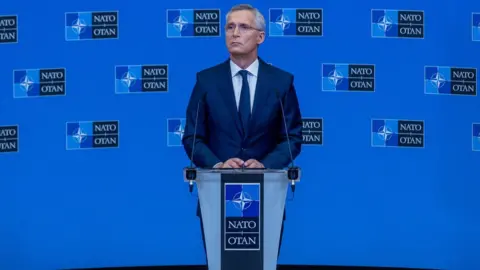Nato plans huge upgrade in rapid reaction force
 Getty Images
Getty ImagesNato has announced plans to massively increase the number of its forces at high readiness to over 300,000 troops.
The bloc's rapid reaction force currently has 40,000 troops at its disposal, with many of those based along the alliance's eastern flank.
Secretary-General Jens Stoltenberg said the increase followed a direct threat from Russia to European security.
He earlier said that "the new military blueprint" would "drastically upgrade" the bloc's eastern defences.
Mr Stoltenberg said several Nato battlegroups in eastern Europe would be bolstered to "brigade level" - tactical units of several thousand troops - which the bloc's civilian leader said was intended to send a clear message of deterrence to Russia.
"I'm confident that Moscow, President Putin, understands our collective security guarantees, understands the consequence of attacking a Nato-allied country," Mr Stoltenberg told reporters at a news conference in Brussels.
"It will trigger a response from the whole Alliance. And to underpin that message, we are increasing the Nato presence."
Nato's rapid reaction force is a combination of land, sea and air assets designed to be deployed quickly in the event of attack. It has steadily grown in size from 13,000 troops to 40,000 since 2014.
Following Russia's invasion of Ukraine, many of these forces were placed at "high readiness" for the first time. Multinational battlegroups are now active in a number of countries on Russia's border, including Latvia, Estonia, Lithuania and Poland.
There are additional plans to deploy more battlegroups in Bulgaria, Hungary, Romania and Slovakia.
The moves announced by Mr Stoltenberg are expected to be approved at this week's Nato summit in Madrid, which will follow the G7 meeting of industrial democracies currently taking place in Germany.
Members are also expected to change the alliance's official stance towards Russia, which was adopted in 2010 and described Moscow as a "strategic partner".
"That will not be the case in the strategic concept that we will agree in Madrid," Mr Stoltenberg told reporters. "I expect that allies will state clearly that Russia poses a direct threat to our security, to our values, to the rules-based international order."
US officials have also briefed that new, "strong" language will be adopted towards China.
Both the US and UK have reportedly pushed for a more forceful stance to combat what they see as an increasing threat of attack against the democratic island of Taiwan by Beijing.
But Nato diplomats told the Reuters news agency that France and Germany prefer adopting more restrained measures to tackle China.

A message to Moscow

Jens Stoltenberg describes the huge increase in Nato's quick reaction force as part of "the biggest overhaul of our collective deterrence and defence since the Cold War".
The current Nato response force is around 40,000 strong with, in theory, military personnel ready to deploy within 15 days. Nato says the new response force will provide a much larger pool of high readiness forces across land, sea and air.
Again, in theory, some of the 300,000 will be able to deploy within days, others over a longer period. An official said there would be "different tiers of readiness".
This is clearly designed to send Russia a message, which has now become "the most significant and direct threat to the alliance".
It's also meant to reassure those allies with borders closest to Russia. Nato first deployed battlegroups of around 1,000 troops to each of the Baltic states in response to Russia's invasion of Crimea in 2014.
With the invasion of Ukraine, Nato have already sent hundreds more and is ready to expand those forces. But is that enough to satisfy members who wanted to see a sizeable increase in Nato forces in their own countries - like the Baltic states?
Keeping troops at high readiness in their own countries is clearly a compromise - and the less costly option.